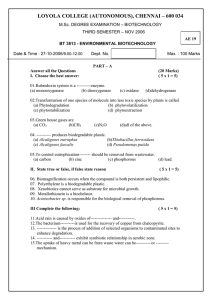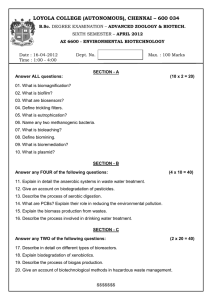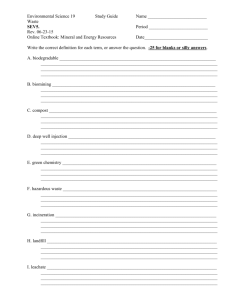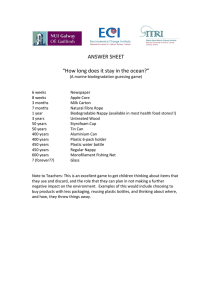Understanding Biobased/Biodegradable and the Industry`s
advertisement
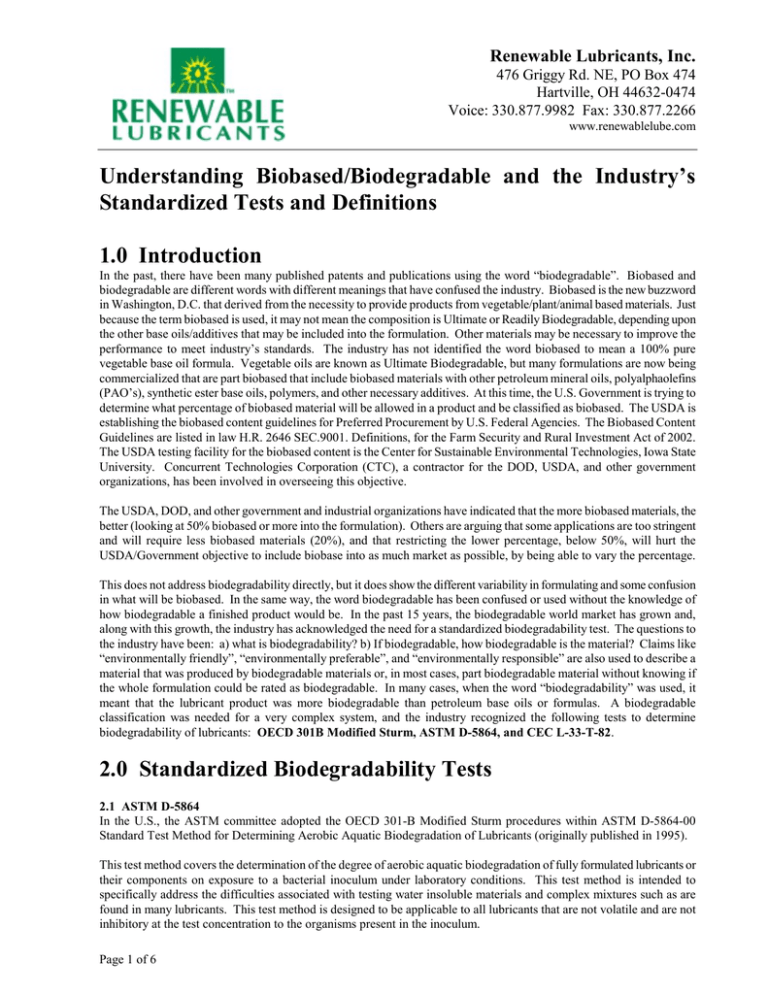
Renewable Lubricants, Inc. 476 Griggy Rd. NE, PO Box 474 Hartville, OH 44632-0474 Voice: 330.877.9982 Fax: 330.877.2266 www.renewablelube.com Understanding Biobased/Biodegradable and the Industry’s Standardized Tests and Definitions 1.0 Introduction In the past, there have been many published patents and publications using the word “biodegradable”. Biobased and biodegradable are different words with different meanings that have confused the industry. Biobased is the new buzzword in Washington, D.C. that derived from the necessity to provide products from vegetable/plant/animal based materials. Just because the term biobased is used, it may not mean the composition is Ultimate or Readily Biodegradable, depending upon the other base oils/additives that may be included into the formulation. Other materials may be necessary to improve the performance to meet industry’s standards. The industry has not identified the word biobased to mean a 100% pure vegetable base oil formula. Vegetable oils are known as Ultimate Biodegradable, but many formulations are now being commercialized that are part biobased that include biobased materials with other petroleum mineral oils, polyalphaolefins (PAO’s), synthetic ester base oils, polymers, and other necessary additives. At this time, the U.S. Government is trying to determine what percentage of biobased material will be allowed in a product and be classified as biobased. The USDA is establishing the biobased content guidelines for Preferred Procurement by U.S. Federal Agencies. The Biobased Content Guidelines are listed in law H.R. 2646 SEC.9001. Definitions, for the Farm Security and Rural Investment Act of 2002. The USDA testing facility for the biobased content is the Center for Sustainable Environmental Technologies, Iowa State University. Concurrent Technologies Corporation (CTC), a contractor for the DOD, USDA, and other government organizations, has been involved in overseeing this objective. The USDA, DOD, and other government and industrial organizations have indicated that the more biobased materials, the better (looking at 50% biobased or more into the formulation). Others are arguing that some applications are too stringent and will require less biobased materials (20%), and that restricting the lower percentage, below 50%, will hurt the USDA/Government objective to include biobase into as much market as possible, by being able to vary the percentage. This does not address biodegradability directly, but it does show the different variability in formulating and some confusion in what will be biobased. In the same way, the word biodegradable has been confused or used without the knowledge of how biodegradable a finished product would be. In the past 15 years, the biodegradable world market has grown and, along with this growth, the industry has acknowledged the need for a standardized biodegradability test. The questions to the industry have been: a) what is biodegradability? b) If biodegradable, how biodegradable is the material? Claims like “environmentally friendly”, “environmentally preferable”, and “environmentally responsible” are also used to describe a material that was produced by biodegradable materials or, in most cases, part biodegradable material without knowing if the whole formulation could be rated as biodegradable. In many cases, when the word “biodegradability” was used, it meant that the lubricant product was more biodegradable than petroleum base oils or formulas. A biodegradable classification was needed for a very complex system, and the industry recognized the following tests to determine biodegradability of lubricants: OECD 301B Modified Sturm, ASTM D-5864, and CEC L-33-T-82. 2.0 Standardized Biodegradability Tests 2.1 ASTM D-5864 In the U.S., the ASTM committee adopted the OECD 301-B Modified Sturm procedures within ASTM D-5864-00 Standard Test Method for Determining Aerobic Aquatic Biodegradation of Lubricants (originally published in 1995). This test method covers the determination of the degree of aerobic aquatic biodegradation of fully formulated lubricants or their components on exposure to a bacterial inoculum under laboratory conditions. This test method is intended to specifically address the difficulties associated with testing water insoluble materials and complex mixtures such as are found in many lubricants. This test method is designed to be applicable to all lubricants that are not volatile and are not inhibitory at the test concentration to the organisms present in the inoculum. Page 1 of 6 A substance known to be biodegradable shall be tested simultaneously with the test substance. For water soluble test substances, suggested reference substances are sodium benzoate or aniline. For water insoluble test substances, the suggested reference substance is low erucic acid rapeseed oil, also called LEAR, such as canola oil. The test shall continue for at least 28 days or until the CO2 evolution has reached a plateau. The levels of biodegradability are listed below in the Environmental Persistence Classification. Ultimate Pw1 is the fastest and highest level of biodegradability. The bacterial microorganisms used in biodegradation tests are some of the simplest forms of life, and like all living organisms, are adversely affected by the presence of chemical toxins. In this test the low toxicity of the test sample is demonstrated by the microorganisms’ ability to multiply and biodegrade the sample. Other organizations that have accepted the % theoretical CO2 test method for determining aerobic aquatic biodegradation of lubricants include the ISO, OECD, U.S. EPA, and the EUC. 2.2 Terminology from ASTM D-6046-02: Standard Classification of Hydraulic Fluids for Environmental Impact (Referenced from ASTM D-5864) Ultimate biodegradation, n—degradation achieved when a material is totally utilized by microorganisms resulting in the production of carbon dioxide (and possibly methane in the case of anaerobic biodegradation), water, inorganic compounds, and new microbial cellular constituents (biomass or secretions or both). Ultimate biodegradation test, n—a test which estimates the extent to which the carbon in a material is converted to CO2 or methane, either directly by measuring the production of CO2 or methane, or, for aerobic biodegradation, indirectly by measuring the consumption of O2. 2.3 Environmental Persistence Classification-Aerobic Fresh Water (also used by US Military) Pw1 greater than or equal to 60% in 28 days = Ultimate (ASTM) /Readily (OECD) Biodegradable Pw2 greater than or equal to 60% in 84 days (12 wks) Pw3 greater than or equal to 40% in 84 days (12 wks) Pw4 less than 40% in 84 days (12 wks) 2.4 Tests of Biodegradability in Aerobic Aquatic Environments Test Title Measurements Ultimate Biodegradation Tests: D 5864, Test Method for Determining % theoretical CO2 The Aerobic Aquatic Biodegradation of Lubricants 9429:1990, Technical Corrigendum 1, % theoretical CO2 Water quality-evaluation in an Aqueous medium of the “ultimate” Biodegradability of organic Compounds-Method by analysis of Released carbon dioxide 301B, CO2 Evolution Test (Modified % theoretical CO2 Sturm Test) Aerobic Aquatic Biodegradation Test % theoretical CO2 C.4-C: Carbon Dioxide (CO2) evolution % theoretical CO2 L-33-A-934, Biodegradability of Two% loss of extractable Stroke Cycle Outboard engine Oils in CH2 groups Water (Formerly L-33-T-82) Sponsoring Organization ASTM ISO OECD US EPA EUC CEC 2.5 OECD 301B Modified Sturm The modified Sturm test is adequate for soluble and insoluble organic, non-volatile materials. This test measures carbon dioxide evolved and therefore measures only “complete” oxidation; organic impurities will complicate the interpretation of carbon dioxide production data. Test material is introduced into a flask containing mineral substrate and a bacterial inoculum. After ultrasonic vibration, the flask contents are aerated with carbon dioxide-free air. A control without the test material is run in parallel. Page 2 of 6 Any carbon dioxide released is absorbed in flasks containing barium hydroxide solution. Periodically, the amount of barium hydroxide solution used is determined by titration with hydrochloric acid. Biodegradation is expressed as a percentage of the total amount of carbon dioxide evolved during the test, (corrected for the control), against the theoretical carbon dioxide that the test material could have produced. Normally, the test lasts for 28 days. Tests however may be ended before 28 days, i.e. as soon as the biodegradation curve has reached a plateau for at least three determinations. Tests may also be prolonged beyond 28 days when the curve shows that biodegradation has started but that the plateau has not been reached by day 28, but in such cases the chemical would not be classed as readily biodegradable. The pass levels for Ready Biodegradability are 70% removal of DOC and 60% of ThOD or ThCO2 production for respirometric methods. They are lower in the respirometric methods since, as some of the carbon from the test chemical is incorporated into new cells, the percentage of CO2 produced is lower than the percentage of carbon being used. These pass values have to be reached in a 10-day window within the 28-day period of the test, except where mentioned below. The 10-day window begins when the degree of biodegradation has reached 10% DOC, ThOD or ThCO2 and must end before day 28 of the test. 2.6 CEC L-33-T-82 Test (ref. Lubrizol’s Biodegradability Review of current situation) The CEC L-33-T-82 (now listed as CEC L-33-A-934) test applies to most organic compounds, whether soluble or insoluble in water. It determines the overall biodegradability of hydrocarbons, or similar compounds containing (CH2) methylene groups, measuring all transformations that the starting material undergoes, including oxidation and hydrolysis. It was developed to characterize the biodegradability of outboard engine oils on the Bodensee, due to the accumulation of mineral oils which tainted fish. The CEC test is accepted in a number of Blue Angel Environmental Labels, and requires 80% or greater biodegradability. The German Blue Angel scheme does not intend to produce guidelines for “enclosed” systems. Despite being convenient and easy, the CEC test only measures the IR absorbance of lipophilic molecules extractable into chloroalkane solvent. It does not measure the water-soluble metabolites which are poorly extractable and therefore, cannot measure extensive degradation or mineralization. This would require a parallel test measuring oxygen consumption or carbon dioxide evolution. There is also no clear structural criterion which can be adopted to compare biodegradabilities of various structure types. Although the industry, including the ASTM, ISO, OECD, U.S. EPA, and the EUC, is now accepting the % of theoretical CO2 as the method for determining the biodegradation of lubricants, the CEC method has identified certain trends: 1. Mineral oils, alkylated benzenes, PIB, PAO’s polyalkyleneglycols have poor biodegradability, i.e. 0-40% 2. Vegetable oils (triglycerides), diesters, polyol esters show good biodegradability, (60-100%). N-Alkyl monocarboxylic acids are common in nature and often appear as products from B-decarboxylation of alkane moieties and they are generally as easily degraded as esters. The degradation products are also more soluble, although the effects on the ecosystem and groundwater contamination are not known. 3. Aromatic polycarboxylate esters range from 5-80%. The same molecule can show consistently wide variation suggesting that competent microflora are restricted in their distribution. Polyethers show poor biodegradability in the CEC test, but have the advantage of being water-miscible. Therefore, tests based on oxygen consumption, carbon dioxide evolution or organic carbon removal may be more applicable. By these tests, polyethers are between 0 to 80% biodegradable, depending upon the molecular weight and ethylene oxide/propylene oxide content. Increasing ethylene oxide content and decreasing propylene oxide content give increasing biodegradability. 4. Biodegradability is retarded by the particular alkyl chain lengths (<C4 and >C25) and by the degree of chain branching. 5. Biodegradability depends upon the available nitrogen and phosphorus in the environment and the inoculum size (if the lab test assessment is made after 21 to 28 days). Certain cultures of bacteria utilize tricresyl phosphate and zinc dithiophosphate as carbon and phosphorous sources. N-heterocycles may act as nitrogen sources and, if so, it may be possible deliberately to formulate blends in which the additives might supply the necessary nitrogen, sulphur and phosphorus for total base oil degradation. 6. Additives usually retard the degradation in proportion to their concentration and are themselves poorly degraded, especially heterocyclic structures (triazine, triazole). Summarizing, typical biodegradability values in the CEC L-33-T-82 biodegradability test for common hydrocarbons are: Mineral oil 15 to 35% White oil 25 to 45% Natural & vegetable oil 70 to 100% PAO 5 to 30% Polyether 0 to 25% Page 3 of 6 PIB Phthalate & trimellitate esters Polyols & diesters 0 to 25% 5 to 80% 55 to 100% 3.0 Biodegradability Definitions 3.1 Referenced from Lubrizol’s Biodegradability Review of Current Situation (published in 1993 by Dr. Stephanie Harold) Biodegradability = Biodegradability is not only a property or characteristic of a substance, but is also a system’s concept, i.e. a system with its conditions determines whether a substance within it is biodegraded. When material is released into the environment, its fate depends upon a whole range of physiochemical processes and its interaction with living organisms. The most stable compound of carbon is carbon dioxide. All the more reduced organic compounds are thermodynamically unstable and will be randomly attacked by microbial enzymes, provided that they have some structural similarity to naturally occurring substrates. The California Advertising Statute, amended on April 30, 1991, states that a manufacturer cannot claim that a product is biodegradable unless it meets the following definition: ‘Biodegradable means that a material has the proven capability to decompose in the most common environment where the material is disposed of within 3 years through natural biological processes into nontoxic carbonaceous soil, water, carbon dioxide or methane.’ Primary Biodegradation = Minimal transformation that alters the physical characteristics of a compound while leaving the molecule largely intact. Partial biodegradation is not necessarily a desirable property, since the intermediary metabolites formed can be more toxic than the original substrate. Therefore, mineralization is the preferred aim. Ultimate Biodegradation = Complete biodegradation. Molecular cleavage must be sufficiently extensive to remove biological, toxicological, chemical and physical properties associated with the use of the original product, eventually forming carbon dioxide and water. The Degradation/Accumulation Expert Group of the OECD Environment Committee has established a series of tests which classify compounds as: 1. Readily biodegradable Rapid and complete mineralization. 2. Inherently biodegradable 20-70% biodegradable in 28 days. Requires “worst possible case” estimates of likely environmental concentrations and therefore further simulation tests may be required. 3. Non-biodegradable Negligible biotic removal of material under test conditions. 3.2 EPA Guidelines that List Biodegradable Tests The EPA Office of Prevention, Pesticides, and Toxic Substances (OPPTS 835.3110) has developed this guideline through a process of harmonization that blended the testing guidance and requirements that existed in the Office of Pollution Prevention and Toxics (OPPT) and appeared in Title 40, Chapter I, Subchapter R of the code of Federal Regulations (CFR), the Office of Pesticide Programs (OPP) which appeared in publications of the National Technical Information Service (NTIS) and the guidelines published by the Organization for Economic Cooperation and Development (OECD). OECD’s test most recognized in the lubricant industry, and listed in the EPA Guidelines, is OECD 301-B CO2 Evaluation Test (Modified Sturm): Biodegradability Assessment for Water Soluble and Insoluble Chemical Compounds and Formulations 3.3 Definitions from the EPA OPPTS 835.3110 and OECD Guideline Primary Biodegradation is the alteration in the chemical structure of a substance, brought about by biological action, resulting in the loss of a specific property of that substance. Ultimate biodegradation (aerobic) is the level of degradation achieved when the test compound is totally utilized by microorganisms resulting in the production of carbon dioxide, water, mineral salts, and new microbial cellular constituents Page 4 of 6 (biomass). Readily biodegradable is an arbitrary classification of chemicals which have passed certain specified screening tests for ultimate biodegradability; these tests are so stringent that it is assumed that such compounds will rapidly and completely biodegrade in aquatic environments under aerobic conditions. Inherently biodegradable is a classification of chemicals for which there is unequivocal evidence of biodegradation (primary or ultimate) in any test of biodegradability. 3.4 Eurospec (published by EuroLabs Ltd. and referenced from Lubrizol’s Biodegradability Review) Eurospec makes distinctions between readily and inherent biodegradability. Inherent biodegradability is used to describe organic compounds, which are not readily biodegradable within the 28 days, but over prolonged exposure periods, with adapted organisms and lower concentrations of the chemical, will exhibit levels of degradation similar to those, which are readily biodegradable (generally greater than 70% mineralization of the product). A chemical, which shows ultimate biodegradation in this situation, is likely to be considered as non-persistent in the environment. If more accurate information is required on the risk to specific environments, it may be necessary to undertake simulation tests. These are longer-term projects acting as models for actual situations. They must therefore be validated and justified. A failure to show biodegradation after prolonged exposure, renders the chemical as non-biodegradable or persistent. If a product does not pass the 28-day Readily Biodegradability part of the test, the company that owns the product must consider if the Inherent Biodegradable part of the test is cost effective to pursue. Sometimes it may take 84 days to determine the results of Inherent Biodegradability. The industry’s cost of the 28-day test, average $5,000.00 per sample, can more than double for the continued study. It is very unlikely that a company will pursue an Inherently Biodegradable label if the industry prefers Ultimate/Readily Biodegradable and Inherently Biodegradable may require additional tests. 4.0 Biochemical Mechanics of Hydrocarbon Biodegradation 4.1 Hydrocarbon structure (referenced from Lubrizol’s Biodegradability Review) Petroleum hydrocarbons can be divided into 4 classes: Saturates Aromatics Asphaltenes (phenols, fatty acids, ketones, esters and porphyrins) Resins (pyridines, quinolines, carbozoles, suphoxides and amides) Biodegradation occurs by a series of enzyme-catalyzed oxidation reactions. A terminal alkyl group is oxidized to an aldehyde, then to a longchain carboxylic acid. After repeated degradation through B-oxidation in the fatty acid cycle to acetic acid and a lower C-number carboxylic acid, the acetic acid is oxidized in the Krebs (citric acid) cycle to carbon dioxide and water. Hydrocarbons differ in their susceptibility to microbial attack, and in order of their decreasing susceptibility: n-alkanes > branched alkanes > low molecular weight aromatics > cyclic alkanes In general terms, biodegradation rates for the saturates > light aromatics > high molecular weight aromatics > polar compounds Qualitative relationships have facilitated the synthesis and development of compounds which maybe discharged to the environment with reasonable safety, and these may be summarized in terms of hydrocarbon structure. (i) Straight-chain hydrocarbon degradation In the aliphatic fraction, n-alkanes can be completely degraded most readily. At high molecular weights, >C18, n-alkanes exist as waxes, and the rate of assimilation is greatly slowed by the problem of mass transfer of solid substances into cells, although n-alkanes up to C44 can be metabolized by mixed populations of soil organisms. The presence of 1 or more double bonds makes olefins more resistant to complete degradation, despite the fact that hydroxylation and epoxidation of double bonds is well known biochemically. Cyclo-alkanes are degraded after adaptation of the microorganisms, and resistance to degradation increases with the number of fused rings in the molecule. Structures with 4 or more condensed Page 5 of 6 rings may be co-oxidized in the presence of a co-substrate. (ii) Branched hydrocarbon degradation Branching generally makes an alkane more resistant to biodegradation. Although methyl-branched compounds, e.g. phytane and pristine are degraded by a number of organisms, they tend to be more persistent than other saturates in crude oil. (iii) Aromatic degradation Aromatic hydrocarbons are degraded to form aryl acids, but less readily as the number of condensed aromatic rings increase. Some of the intermediates formed are conjugated and exist as water-soluble glucuronides and suphates. Ring substitutions can interfere with metabolism; certain of the metabolites produced are known carcinogens. Aromatic functional groups such as hydroxyl and carboxylate groups increase biodegradability, whereas halogen, nitro and sulphonate groups decrease the rate of biodegradation. Ortho-substituted aromatic compounds are slightly more biodegradable than para-substituted compounds, and the meta-substituted compounds have the least biodegradable substitution pattern. Only the simplest forms of polycyclic aromatics, (PCAs), i.e. naphthalene, anthracene and phenanthrene can easily support microbial growth. PCAs containing 4 or 5 rings are relatively resistant to biodegradation and previous studies had failed to isolate microorganisms capable of degrading them. A Mycobacterium that degrades pyrene and other polycyclic aromatics has now been isolated. Induction of enzymes for polyaromatic hydrocarbon, (PAH), degradation depends upon lower molecular weight aromatics such as naphthalene. The finding that the enzymes for degrading at least some PAHs are not induced by the substrate itself is important, and may explain the apparent resistance of these compounds to microbial attack. Although cometabolism has been suggested as the mechanism for enhanced rates of 4- or 5- ring PAH degradation in the presence of 3-ring aromatic hydrocarbons in the soil, it is possible that enzyme induction by the simpler aromatic hydrocarbons is important in determining the rates of higher condensed ring aromatic hydrocarbon degradation. (iv) Asphaltic degradation The asphaltic fraction is the most resistant to biodegradation and is the most persistent in freshwater ecosystems. Little is known of the metabolism of individual compounds in this fraction. It is probable that some compounds in the asphaltic fraction are not biodegradable, or that they are degraded so slowly that they should be considered non-degradable. An oil may be removed from an area by physical factors, e.g. tides or currents, or it may be covered over by sediment, but some of its components cannot be metabolized and will persist. Claims that all oil, or more than 50% of heavy crudes, may be removed by microbial metabolism may be exaggerated. Attack on hydrocarbons by oxygenases produces free radicals and other reactive intermediates that may chemically react with each other, forming partially oxygenated, crosslinked, high molecular weight asphaltenes that are quite resistant to further biodegradation. Striking examples of these “synthetic” transformations in the course of petroleum biodegradation are the formation of high molecular weight n-alkanes not originally present in petroleums and the build-up of lipid-rich “petroleum dirt” residue from gaseous methane by methanotrophs. In soils repeatedly treated with oily wastes, a gradual build-up of biodegradation-resistant hydrocarbons can be observed. Page 6 of 6
